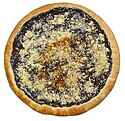
Hungarian or Magyar cuisine is the cuisine characteristic of the nation of Hungary, and its primary ethnic group, the Magyars. Hungarian cuisine has been described as being the spiciest cuisine in Europe. This can largely be attributed to the use of their piquant native spice, Hungarian paprika, in many of their dishes. A mild version of the spice, Hungarian sweet paprika, is commonly used as an alternative. Traditional Hungarian dishes are primarily based on meats, seasonal vegetables, fruits, bread, and dairy products.
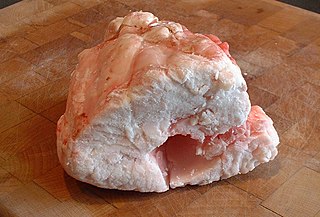
Suet is the raw, hard fat of beef, lamb or mutton found around the loins and kidneys.

Jewish cuisine refers to the worldwide cooking traditions of the Jewish people. During its evolution over the course of many centuries, it has been shaped by Jewish dietary laws (kashrut), Jewish festivals and holidays, and traditions centred around Shabbat. Jewish cuisine is influenced by the economics, agriculture, and culinary traditions of the many countries where Jewish communities have settled and varies widely throughout the entire world.
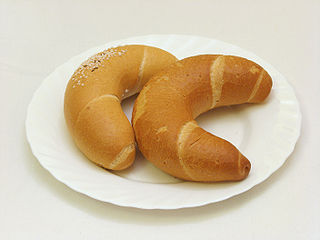
Kifli, kiflice, kifle, or kipferl is a traditional yeast bread roll that is rolled and formed into a crescent before baking.

Fruit curd is a dessert spread and topping. It is usually made with citrus fruit, though may be made with other fruits. Curds are often used as spreads and as flavorings.

Summer pudding or summer fruit pudding is an English dessert made of sliced white bread, layered in a deep bowl with fruit and fruit juice. It is left to soak overnight and turned out onto a plate. The dessert was most popular from the late 19th to the early 20th century. It first appears in print with its current name in 1904, but identical recipes for 'hydropathic pudding' and 'Malvern pudding' from as far back as 1868 have been found.

Ottoman cuisine is the cuisine of the Ottoman Empire and its continuation in the cuisines of Turkey, the Balkans, Caucasus, Middle East and Northern Africa.
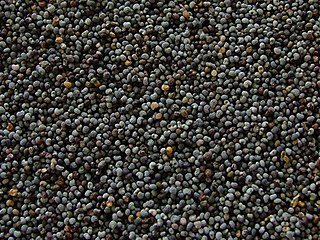
Poppy seed is an oilseed obtained from the opium poppy. The tiny, kidney-shaped seeds have been harvested from dried seed pods by various civilizations for thousands of years. It is still widely used in many countries, especially in Central Europe and South Asia, where it is legally grown and sold in shops. The seeds are used whole or ground into meal as an ingredient in many foods – especially in pastry and bread – and they are pressed to yield poppyseed oil.

Sephardic Jewish cuisine is an assortment of cooking traditions that developed among the Sephardi Jews.

Knafeh is a traditional Middle Eastern dessert, made with spun pastry called kataifi, soaked in a sweet, sugar-based syrup called attar, and typically layered with cheese, or with other ingredients such as clotted cream, pistachio or nuts, depending on the region. It is popular in the Middle East. In Turkey, it is called künefe.

The poppy seed roll is a pastry consisting of a roll of sweet yeast bread with a dense, rich, bittersweet filling of poppy seed. An alternative filling is a paste of minced walnuts, or minced chestnuts.

Mizrahi Jewish cuisine is an assortment of cooking traditions that developed among the Jews of the Middle East, North Africa, Asia, and Arab countries. Mizrahi Jews have also been known as Oriental Jews.

This is a list of prepared-foods list articles on Wikipedia.
Romani cuisine is the cuisine of the ethnic Romani people. There is no specific "Roma cuisine"; it varies and is culinarily influenced by the respective countries where they have often lived for centuries. Hence, it is influenced by European cuisine even though the Romani people originated from the Indian subcontinent. Their cookery incorporates Indian and South Asian influences, but is also very similar to Hungarian cuisine. The many cultures that the Roma contacted are reflected in their cooking, resulting in many different cuisines. Some of these cultures are Middle European, Germany, Great Britain, and Spain. The cuisine of Muslim Romani people is also influenced by Balkan cuisine and Turkish cuisine. Many Roma do not eat food prepared by a non-Roma.

Bulgur, or burghul, is a cracked wheat foodstuff found in West Asian cuisine.
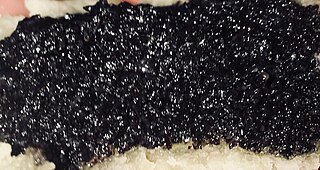
Poppy seed paste, also known as mohn, is a common ingredient in Ashkenazi Jewish pastries and desserts. It is made from ground poppy seeds and additional sweeteners. Examples of pastries featuring the filling include mohn kichel, babka, and, most famously, hamantashen. In Jewish cuisine, the filling is traditionally referred to as mohn, the word for poppy in both Yiddish and German. Poppy seed-filled pastries are particularly associated with the holiday of Purim.













